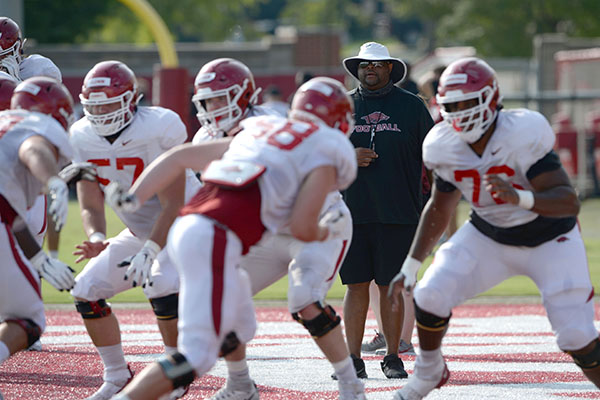All my life I’ve heard that the key to playing football was blocking and tackling. It’s boring stuff to most. They’d rather draw up plays and pretend to be the coordinator.
At the risk of losing all but a few, this space will be entirely devoted to just blocking. Tackling will have to wait for another day.
I’m a pretty boring guy by all accounts. My fly fishing is often relegated to just one fly. I fish the ruby midge in all streams to the point my buddies switch to that fly without asking.
“Clay is on a hot streak,” they think. “The ruby midge must be working.”
Later at a lunch break sitting on a log, they are dumbfounded when they see my caddis pupae. Who knew I fished anything but a ruby?
They should have asked. And, if you wondered how the offensive guards played on any given day, just ask, because I’ll probably know. That’s what I watch. It’s as much a sure thing as a ruby midge.
One of the great offensive line coaches taught me to watch the center and guards through field glasses to understand football. Merv Johnson coached me on how to “see” the game in the spring of 1979. I’ve been indebted ever since.
Johnson had just arrived at Oklahoma to coach the offensive line under Barry Switzer. That began a 41-year association with the Sooners that apparently has ended this month as Johnson announced his retirement as analyst from the OU radio booth.
Johnson is the best to have coached that position. Also, there’s never been a better person. Forget that he coached offensive lines that won three national titles, Johnson is just a championship human being.
Still in my first year at the Tulsa World, I met Johnson in his office to talk about old times. He requested the meeting. He knew my parents during his time on Frank Broyles’ staffs at Arkansas (1962-64). He asked about my mother first and went through the names of my entire family.
Then, we got down to football. Oh, what a fun day it was to pick the brain of a technical offensive line genius.
Johnson coached the Arkansas offensive line in 1964 when the Hogs won their only national football title. Johnson won a second national title ring at Notre Dame in 1977. He would earn another at OU in 1985.
Johnson put on film to watch OU’s 1978 team for an O-line tutorial. He asked me to watch guard Greg Roberts, the Outland Trophy winner.
“Don’t watch Billy Sims,” Johnson said. “Let’s just watch Roberts. Where he goes, Billy will show up.
“And, if you focus on the center, you will see Roberts, and the other guard. Watching the center puts all three in your vision.”
It was like someone had lifted the fog in my brain on what actually happens on a football field.
“Watch them at the initial point of their block, but don’t look for the ball,” Johnson said. “Watch them as they continue downfield.”
Suddenly, things I had never seen in a game began to become crystal clear. I realized the guards were either getting a linebacker or a strong safety — or they were not. Great open field running took advantage of those situations — or they did not.
Convinced I’d grasped those concepts, Johnson said, “Now we are going to get to the crux of football, pad level. You either have it or you don’t. If you are an athlete as a lineman, you can bend at the waist. If you are not, you are a sitting duck.”
That’s on either side of the line, Johnson said.
“The great linemen can bend at the waist and play with their pads low to the ground,” he said. “Those are the ones who gain leverage. With leverage, you can claim real estate and push through your man. Those that play with high pads are drilled backward.
“The good teams win the line of scrimmage through leverage and that comes from low pad level. The teams with better athletes at the line of scrimmage dominate the game because of pad level. You win third-and-1 with pad level. You win on the goal line with pad level.”
It made perfect sense, but I’d never known any of that. I’d never heard it mentioned by one coach. And, I’d never heard one sportswriter ask about it.
Over the last 41 years, I’ve asked about it plenty. Sometimes coaches will talk about it, sometimes they just sit in amazement that it’s being discussed.
It was among the first questions I asked Sam Pittman when he became Bret Bielema’s offensive line coach in 2013. I prefaced the question with a mention that Johnson had coached me to watch for pad level in 1979.
“You learned from a good one,” Pittman said. “No, he was a great one.”
That should preface that the only purpose in going to watch 15 minutes of Tuesday’s practice was to check pad level for the Arkansas offensive line. My eyes never left the work being done with the O-line by both Brad Davis and Pittman.
Davis played for Pittman two years at Oklahoma and worked for Pittman at North Carolina. They are like father-son, according to both. To watch them work with the Arkansas line on Tuesday was a treat.
The three periods for media viewing started with Pittman in another area, but he arrived as the padded workout moved to contact with O-linemen working against O-linemen to get the looks for plays scheduled to be run later in the day.
Davis had two centers working, one with the left side of the line, then another with the right side. Backups were designated as defensive linemen. There would be five or six aggressive steps before a whistle. Tight ends were eventually added.
While Davis coached on one side, Pittman would add subtle thoughts on the other side. And sometimes it was not so subtle.
“You going to hit someone?” Pittman challenged a player as soon as he arrived on the scene. “I haven’t seen that yet!”
Then, the player exploded into his opponent with Pittman applauding and calling out the number of the player in question. “Great, great,” he said.
A few seconds later, Pittman said, “To be physical on game day, you are going to have to be physical in practice.”
Then, he called out a player for lack of pad level, then said, “If you are going to move a man, you better get lower than that. You can move a great athlete, but not without pad level.”
It was exactly what I wanted to hear. And, it was everything I wanted to see from this group of linemen.
Some are still tall and lean. Noah Gatlin, working at right tackle Tuesday, is heavier than his last two years, but can still add more weight. He’s listed at 307 pounds and has more room on his 6-7 frame. I’m guessing he’ll be 315 by next season.
There were players missing Tuesday, presumably because of covid-19 quarantine. What I saw had Myron Cunningham at left tackle, Brady Latham at left guard, Shane Clenin at center, Beaux Limmer at right guard and Gatlin at right tackle.
Those not present with a chance to be in the mix for playing time: center Ricky Stromberg, guard Ty Clary and tackle Dalton Wagner. Stromberg is the likely starter at center. Wagner and Gatlin might split time at right tackle.
The scouting report is that this line is both bigger and nastier than the last three or four. Latham and Gatlin are nasty and are accused of playing well past the whistle by their defensive mates. Stromberg doesn’t back down, either. Fights are common in practice. That’s a great sign.
If you made it this far, you know the key question is getting answered on a daily basis at Arkansas practices. Linemen are playing with lower pads. They are more physical.
However, there are issues. Not everyone is at practice every day. Quarantine has robbed this team of valuable snaps under these new offensive line coaches with great demands on physical attitude and pad level.
The way to playing well in games is to be at practice every day. A 10-day break because of virus exposure slows pad level development.
The roster shows that Pittman has a bigger team. He just needs time to get all of his big men playing with a bend and physical pad level.
I saw enough Tuesday to know it’s just a matter of time until Arkansas football is back. I’ll check out the tackling another day, but the blocking part eventually will be plenty good.
Credit: Source link































